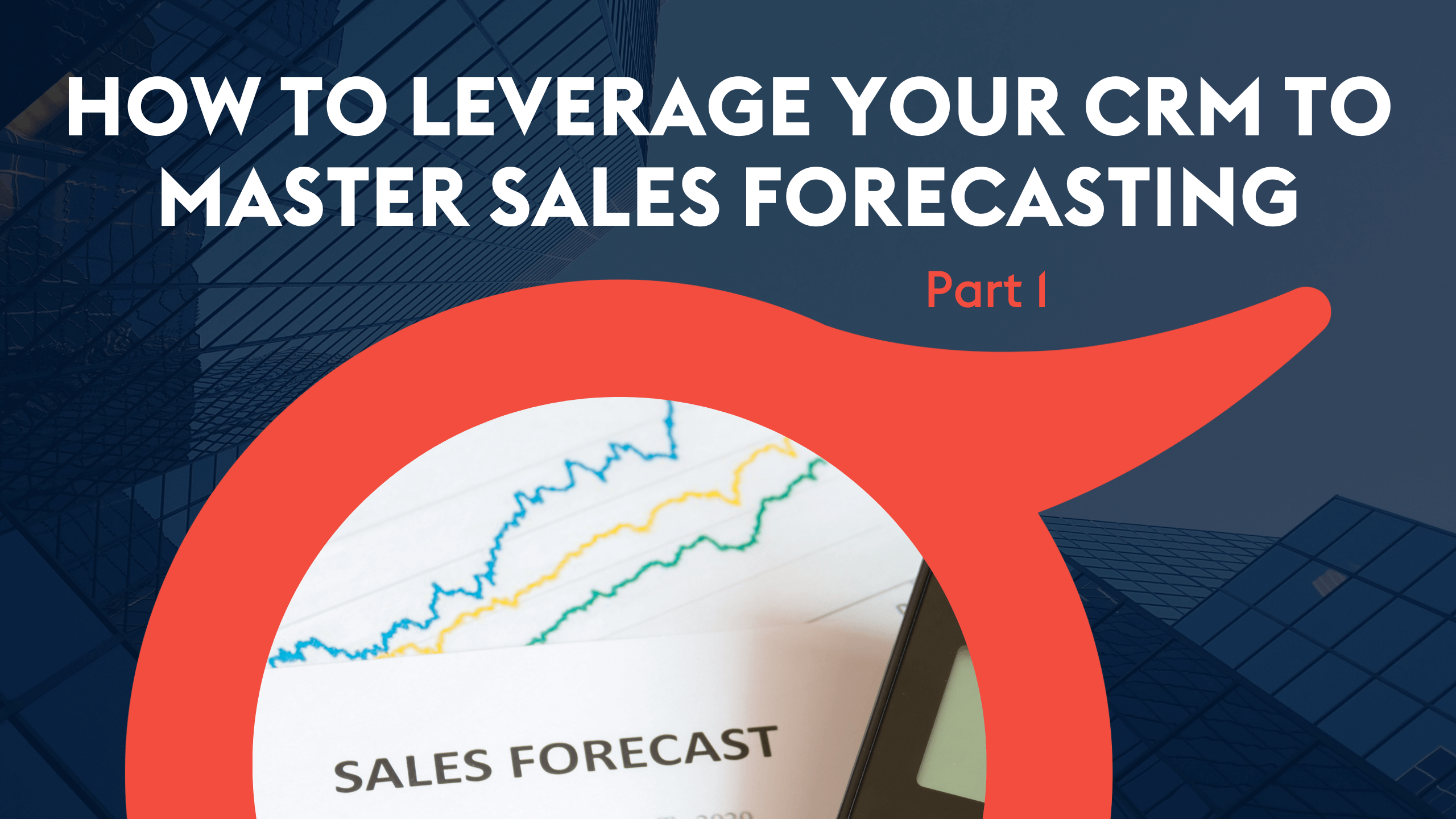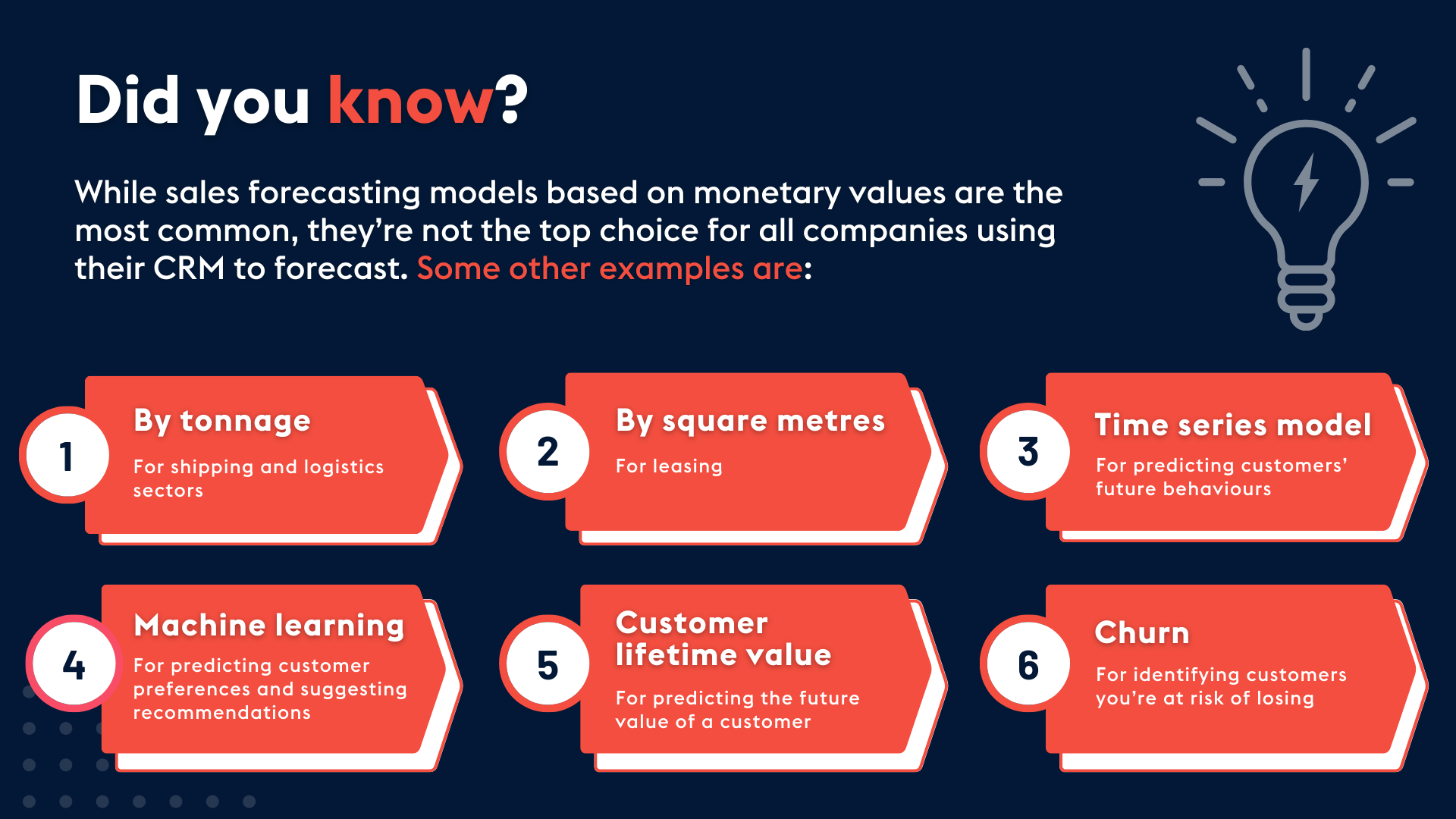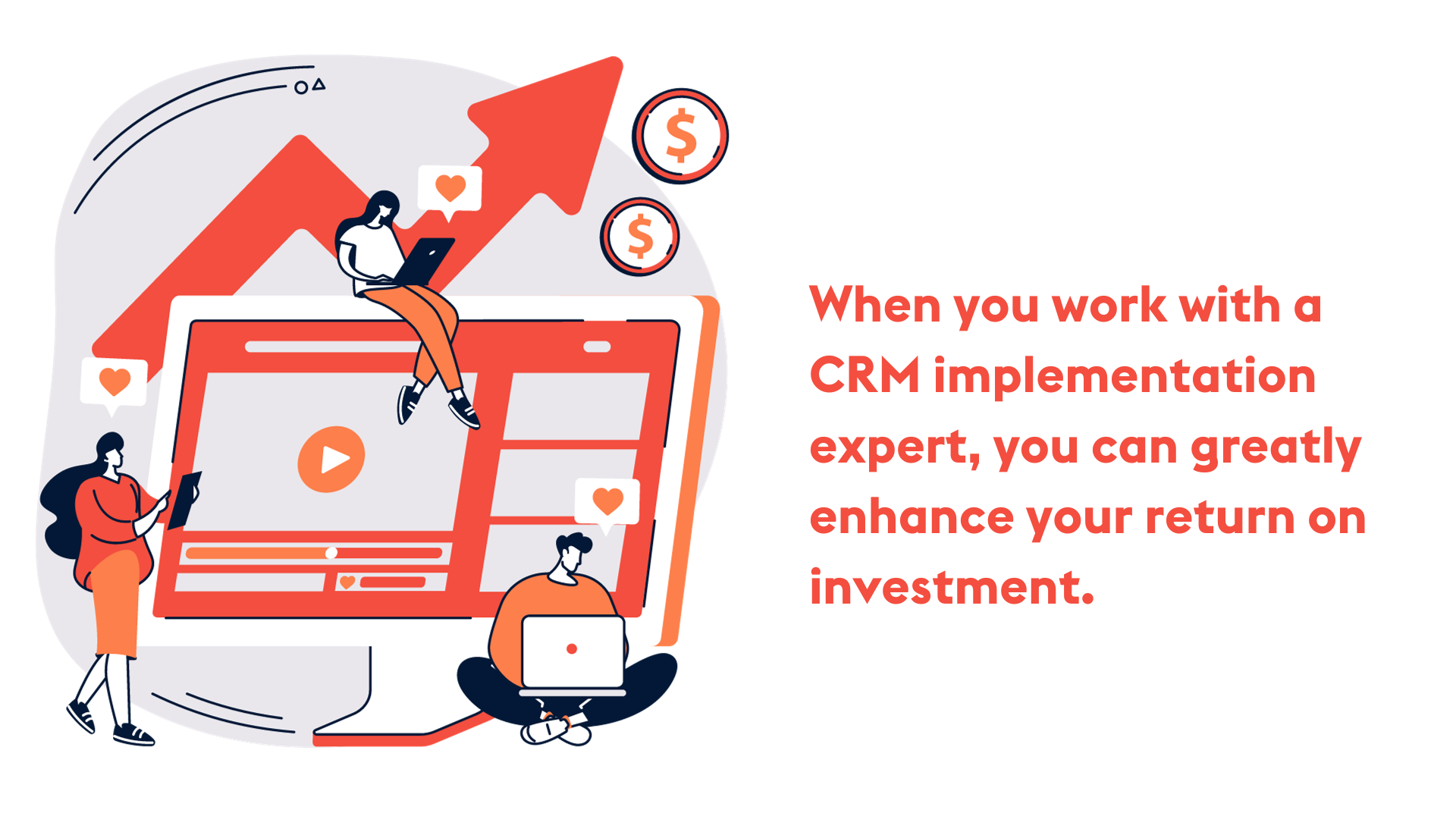
Accurate sales forecasting empowers your people to make proactive, data-driven decisions to optimise your operations, minimise your risks and capitalise on growth opportunities. Proper sales forecasts also create a foundation for effective planning and execution across every department and function within your company. And all that can happen right from your CRM.
Selected and rolled out right, your CRM will be the centralised, go-to platform your business needs to:
In other words, to safeguard factors that are vital for sustained growth and success.
Here, I dive into why accurate sales forecasts are essential for better business decisions, how to choose the right forecasting model for your business, and how to tailor your CRM to suit that model.
Accurate sales forecasts are — or should be — your people’s go-to for informing strategic decision-making. Done right, your forecasts will provide insights into current market trends, customer preferences and your competitive landscape.
As such, they’re instrumental in guiding decisions on product development, business growth and market expansion. What’s more, accurate sales forecasts don’t just help your salespeople hit their targets; they shift your whole company closer to its goals.
Here’s my high-level take on how:
Resource allocation: Accurate sales forecasts help you predict future demand, to adjust your production, staffing, distribution planning and inventories to suit. You’ll ensure you have all the resources you need, without overcommitting. Ideal.
Production planning: Forecasting sales enables optimising your production schedules, avoiding overproduction and ensuring timely product delivery. And, overall, enhancing your operational efficiency.
Proper planning also helps reduce wastage. Both in terms of optimally using your time and investment, and helping your business meet sustainability goals. (Understanding these types of fluctuations in coming weeks or months keeps all industries in balance, but it’s especially crucial for our clients in manufacturing and the food/beverage industry.)
Financial planning: With accurate predictions of revenue and cash flow, your teams can set realistic financial goals. Properly allocate funds across your initiatives, and reliably set budgets for each team. This insight is also essential to securing any financing you need.
Winning investment: Investors and stakeholders rely on accurate sales forecasts to evaluate a firm’s financial health and growth potential. Only with accurate forecasts can you enhance investor confidence and attract funding — and VUCA dynamics intensify this.
Marketing strategies: Proper sales forecasts focus your marketing efforts on your highest-potential groups. Tailor your advertising, promotions and product launches to coincide with periods of expected high demand; maximise the impact of your campaigns.
Plus, if your sales forecasts show a weaker pipeline, marketing will know exactly which products need a boost and messaging refresh.
Risk management: With a clear understanding of future sales trends, you can spot potential risks and opportunities. Capitalise on the ups and develop contingency plans for the downs, shaping your strategies to — as far as possible — mitigate risks from market fluctuations and unforeseen events.
Sales forecasting models based on monetary values are the most common, but they’re not the top choice for all companies using their CRM to forecast. Let’s get straight into the examples:
By tonnage: For one company I worked with in the shipping and logistics sector, tonnage transported per customer was the priority information. With clear month-on-month tonnage reports from their CRM, they could easily track performance per customer. And their salespeople didn’t need to track monetary values; those were all calculated in the system backend.
By square metres: Another client renting out office spaces needed forecasting in sqm per month. By getting to know the firm’s business model, processes and reporting needs, the Provident CRM team tailored its CRM forecasting to suit.
Time series model: This forecasts trends and patterns over time, so you can apply them in your CRM to predict your customers’ future (purchase) behaviour. This links back to resource planning: if you can forecast potential call volume, website traffic and orders, for example, you can staff accordingly. Avoiding overwhelm, and ensuring you provide the quality service your customers expect from you.
Machine learning and collaborative filtering: Let’s take e-commerce as an example here. These techniques can be used to predict customer preferences and suggest personalised product recommendations. By analysing your customers’ purchase history, browsing behaviour, and the preferences of customers with similar profiles, you could enhance your shopping experience. Overall, driving sales and adding to your forecast — all within your tailored CRM.
Customer lifetime value (CLV): This model predicts the future value a customer will bring your business, throughout their relationship with you. CLV helps you segment customers based on potential value, and tailor your marketing efforts accordingly. This links back to how forecasting supports strategic allocation of your company’s resources: knowing where (potential) customer value sits, you can effectively strategise to maximise interest and loyalty.
Churn prediction: Identify customers you’re at risk of losing — and put the work in to win them back! Analysing customer behaviour, product and/or service uptake, engagement levels and historical data will give you useful indicators.
In fact, all types of forecasting models give you handy insights into when (and how) you can proactively retain valuable customers. These insights are useful across your teams:
A final note: Of course, if you’re not tracking your monetary value in your CRM forecasts, you’ll be housing that information elsewhere. Your accounting platform or ERP system, for example, which your CRM should seamlessly talk to.

Whatever your preferred forecasting model, customising your CRM to align with it comes next. That’s the only route to accurate, effective sales forecasting. So here are the key areas to focus on:
Data integration and quality
Your chosen CRM needs to capture and integrate all your relevant data sources. And, crucially, nothing else! Pinpointing the data you need, and ensuring its quality, is an essential first step.
Your relevant data will likely include:
Data preparation
This process will depend on your chosen forecasting model. You may need to aggregate data to appropriate time intervals, or gauge how to handle any missing data values (perhaps integrating them from a source outside your CRM, like your accounting system).
When the Provident CRM team supports our clients with CRM customisation, we get to know your processes, and data input, reporting and forecasting needs, to lay the foundations for accurate outputs.
Identify and create needed features
Next up, we help customers select and roll out the CRM features they need for proper forecasting. If you’re using a machine learning/AI prediction model, for example, you’ll need to look at factors such as:
These insights will help shape your marketing campaigns based on interests per demographic. Plus, which of your touchpoints they’re finding most engaging.
A user-friendly interface
This is vital for uptake amongst your team — an effortless user experience is everything with CRM. The key to useful forecasting is customising your user views. This enables seamless interaction with (and interpretation of) the predictions and reports your CRM generates.
Insights at a glance
Getting your CRM visualisations right will give your people immediate insights into:
All at a glance, so all your teams know precisely what to do next with each customer.
Customised reports and alerts
Many CRMs come with various off-the-shelf reports, but I guarantee you’ll want custom reports and alerts based on your forecasting results. The right reports provide the right insights, for the right decision-making. Simple — when it’s done utterly right!
Collaboration and integration
When all your teams can access and contribute to your CRM forecasting process, collaboration can soar. Sales, marketing, finance, customer service, etc. will likely need some bespoke features and functions, too.
With a quality CRM implementation, you can ensure everyone has the views and tools they need. Crucially, without unnecessarily complicating your processes. Integrations with ERP, BI or accounting tools should be seamless. They’ll funnel in the right data from each of your departments, to enhance your sales forecasting.
Scalability and flexibility
Last but definitely not least, you need to select a CRM platform that will grow with your business. Your as-is scenarios likely look different to your future goal scenarios, and your CRM will need to adapt and scale. The last thing you need is to be hit by a foreseeable cost barrier as you grow! Bear in mind future needs regarding data volumes, new variables, additional integrations, forecasting model modifications, and so on. Control and foresight are key, and we work with our clients to ensure they’re guaranteed.
The goal here is to create a CRM system that not only supports your chosen forecasting model but also aligns with your unique business needs and circumstances — now and in future.
Done right, a CRM is a forward-thinking investment that will set your business up for growth!
So how can our team here at Provident CRM help? We’ve touched on a few factors throughout, but there are a few more worth mentioning:
Faster ROI
A CRM is a significant business investment — one that will only pay off as it should with expert implementation. We’re here to make that happen for you. Working with us means you’ll have your CRM rolled out sooner, and properly set up to suit your teams’ needs.
From sorting your data input basics to the finishing touches on your CRM’s user experience, we work to boost ROI at every turn. You’ll feel the benefits much sooner than if you were going solo!
 Best practices, first time
Best practices, first time
Our team’s gathered decades of expertise, all so we can guide you to optimal CRM solutions. We’ve got a thorough understanding of the CRMs that we work with — both what they’re capable of now, and the evolutions coming down the pipeline. That means we can recommend not just what’s best for your business as-is, but what will best support its growth over the coming years.
The best part? More often than not, new needs that’ll crop up for you can be addressed within your existing CRM licence (without additional spending). Leave it with us — we’ll get it done!
Tailored training and ongoing support
I’ve brought up the importance of CRM uptake under several themes in this piece, but it really can’t be overestimated! You can set up your technical CRM backbone perfectly and sort your seamless workflows, but if your people aren’t ready and willing to make your CRM core to their daily work, it simply won’t deliver. That’s why we place such emphasis on personalised onboarding, continuous training and proactive user support at Provident CRM.
Once your teams see exactly how your CRM makes their lives much easier — rather than being an admin burden — uptake naturally snowballs. That’s the tipping point: effective CRM utilisation soon becomes accurate sales forecasting, and surpassed expectations.
Refining your forecasting strategies
As your business grows, your forecasting strategies will need to evolve. We’ll be on hand to guide every shift — having built in the adaptability you need right from the start, of course. Our Customer Success team is available to continually optimise your processes, and elevate decision-making by fine-tuning the insights you gain from your CRM.
Strengthen your customer relationships, streamline your operations and processes, unlock avenues for business expansion and, of course, ace your sales forecasting. It all comes down to better understanding what’s happened before, to better prepare for all that’s to come. That’s what collaborating with an experienced CRM implementation partner feels like!
To get started, let us know your CRM sales forecasting needs via the link below.